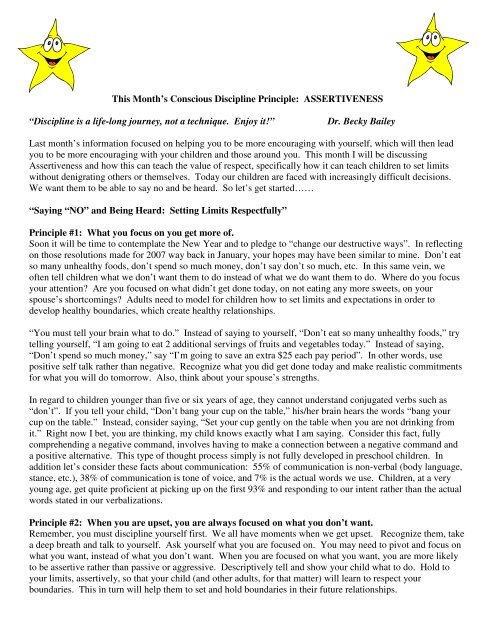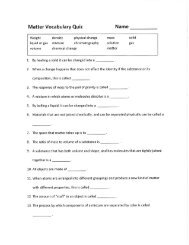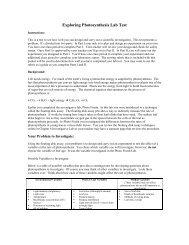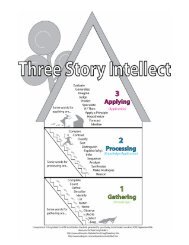This Month's Conscious Discipline Principle: ASSERTIVENESS ...
This Month's Conscious Discipline Principle: ASSERTIVENESS ...
This Month's Conscious Discipline Principle: ASSERTIVENESS ...
Create successful ePaper yourself
Turn your PDF publications into a flip-book with our unique Google optimized e-Paper software.
<strong>This</strong> Month’s <strong>Conscious</strong> <strong>Discipline</strong> <strong>Principle</strong>: <strong>ASSERTIVENESS</strong>“<strong>Discipline</strong> is a life-long journey, not a technique. Enjoy it!”Dr. Becky BaileyLast month’s information focused on helping you to be more encouraging with yourself, which will then leadyou to be more encouraging with your children and those around you. <strong>This</strong> month I will be discussingAssertiveness and how this can teach the value of respect, specifically how it can teach children to set limitswithout denigrating others or themselves. Today our children are faced with increasingly difficult decisions.We want them to be able to say no and be heard. So let’s get started……“Saying “NO” and Being Heard: Setting Limits Respectfully”<strong>Principle</strong> #1: What you focus on you get more of.Soon it will be time to contemplate the New Year and to pledge to “change our destructive ways”. In reflectingon those resolutions made for 2007 way back in January, your hopes may have been similar to mine. Don’t eatso many unhealthy foods, don’t spend so much money, don’t say don’t so much, etc. In this same vein, weoften tell children what we don’t want them to do instead of what we do want them to do. Where do you focusyour attention? Are you focused on what didn’t get done today, on not eating any more sweets, on yourspouse’s shortcomings? Adults need to model for children how to set limits and expectations in order todevelop healthy boundaries, which create healthy relationships.“You must tell your brain what to do.” Instead of saying to yourself, “Don’t eat so many unhealthy foods,” trytelling yourself, “I am going to eat 2 additional servings of fruits and vegetables today.” Instead of saying,“Don’t spend so much money,” say “I’m going to save an extra $25 each pay period”. In other words, usepositive self talk rather than negative. Recognize what you did get done today and make realistic commitmentsfor what you will do tomorrow. Also, think about your spouse’s strengths.In regard to children younger than five or six years of age, they cannot understand conjugated verbs such as“don’t”. If you tell your child, “Don’t bang your cup on the table,” his/her brain hears the words “bang yourcup on the table.” Instead, consider saying, “Set your cup gently on the table when you are not drinking fromit.” Right now I bet, you are thinking, my child knows exactly what I am saying. Consider this fact, fullycomprehending a negative command, involves having to make a connection between a negative command anda positive alternative. <strong>This</strong> type of thought process simply is not fully developed in preschool children. Inaddition let’s consider these facts about communication: 55% of communication is non-verbal (body language,stance, etc.), 38% of communication is tone of voice, and 7% is the actual words we use. Children, at a veryyoung age, get quite proficient at picking up on the first 93% and responding to our intent rather than the actualwords stated in our verbalizations.<strong>Principle</strong> #2: When you are upset, you are always focused on what you don’t want.Remember, you must discipline yourself first. We all have moments when we get upset. Recognize them, takea deep breath and talk to yourself. Ask yourself what you are focused on. You may need to pivot and focus onwhat you want, instead of what you don’t want. When you are focused on what you want, you are more likelyto be assertive rather than passive or aggressive. Descriptively tell and show your child what to do. Hold toyour limits, assertively, so that your child (and other adults, for that matter) will learn to respect yourboundaries. <strong>This</strong> in turn will help them to set and hold boundaries in their future relationships.
<strong>Principle</strong> #3: Passivity invites aggression, aggression begets aggression and assertiveness dissipatesaggression.Clear communication is the goal. Assertiveness clearly tells children what to do so that they may successfullymeet your expectations. To be assertive in your communications you must:• Tell children what to do. State your wants, needs and expectations clearly and simply. “Give me thescissors. These are too sharp. They could cut you. I will get you a plastic pair.”• Send the nonverbal message “just do it” in the tone of your voice. Match your nonverbal and yourverbal communications. When you do this, you let your child know that you mean what you say.Before your child decides whether to comply with a command, he/she will read your facial expression,tone of voice and gestures. You increase the chances that she/he will obey if you appear confident andin control, sound sure of yourself and use gestures to provide information.• Be clear and direct. Give children choices only when choices really exist. “Are you ready forbedtime?” or “It’s time for bed, OK?” implies that your child has a choice about being ready or not. Ifyou say, “It’s time for bed. Go upstairs and get your pajamas,” you leave your child no choice. Youstated plainly what will happen.• Give children usable information. Give commands that contain, usable, helpful information and avoidrhetorical questions. “Get in your car seat and buckle the seat belt,” is assertive. “Can you show mehow to sit right?” is not.• Own and express your feelings directly. If you say, “I feel angry when you interrupt me,” you arebeing assertive. “Look what you made me do” and “”Can’t you be quiet while I am talking?” areindirect (passive/aggressive) ways to express anger.• Speak in concrete terms. Abstractions like good, bad, nice, etc. can be confusing for young children.Teach children what it is to be good and nice specifically, without relying on labels. “Ask your sister ifyou can play with her by saying: May I please play with you?” is assertive. “Be nice to your sister,” isnot assertive.• Be conscious of the intent behind your communication. The intent behind assertive communicationis clarity. Clarity will help your child be as successful as possible. Show respect for your child andenforce rules without teasing, embarrassing or bullying. Being respectful means focusing on improvingbehavior rather than on getting your child to feel bad about their actions. The intent behind the words ismore powerful than the actual choice of wording.When working with your child try the following steps:1. Move to your child, get down on eye level and make direct eye contact.2. State your child’s name.3. Verbally tell your child what you want him/her to do.4. Touch your child gently on the arm or place your hand on her/his back or shoulder.5. Use visual cues through gesturing to support what you want your child to do.<strong>Principle</strong> #4: Children must learn that they teach others how to treat them. They must learn toassertively deal with intrusive behaviors.Preschool age children constantly struggle to establish boundaries with their peers. If you are passive and/oraggressive with your children when setting limits, they will be passive and/or aggressive with each other. RuthAnn and I invite you to spend some time observing preschool through our observation window. You won’thave to watch long until you witness a situation where we help two children work through a conflict, whichmodels this principle. Here’s a generic example:
Scenario: Child A hits Child B who took Child A’s toy.Ms.Eagan, Mrs. Standridge or I go to the victim first (as long as Child A is not hurting anyone else) and at somepoint ask, “What happened?”Child B: “She hit me.”Ms. Eagan, Mrs. Standridge or I: “Did you like it?Child B: “NO!”Ms. Eagan, Mrs. Standridge or I: “Then tell her ‘I don’t like it when you hit me.’ “ (We model an assertivevoice for the child, and help them to find their BIG voice.)Of course there are many possible scenarios and each situation is different. By giving the children the exactwords to use they gain confidence and develop the skills to solve their own problems assertively.As the New Year approaches I wish you many days filled with fun and fulfilling parenting experiences. Untilnext month…..
















